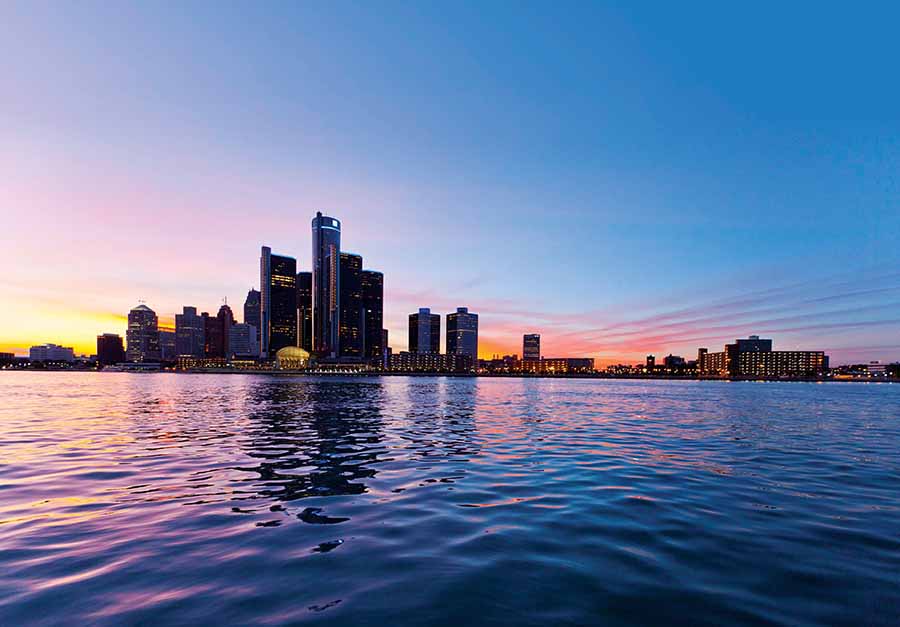
The notion of a local council declaring bankrupt is peculiarly American, with its provision for Chapter 9 (as opposed to the more common Chapter 11) bankruptcy. Detroit were the headline makers in this regard.
Following the Detroit riots of 1967, the city faced decades of economic and social decline, culminating in the largest municipal bankruptcy in U.S. history on 18 July 2013, with debts estimated at $18–20 billion. The bankruptcy, driven by population loss, a shrinking tax base, high unemployment, and mismanaged pension obligations, marked a low point but also catalysed a multifaceted revival.
Following the 1967 riots, Detroit’s decline accelerated in the 1980s and 1990s, driven by economic, social, and political factors that deepened the city’s challenges and further tarnished its reputation. Below is a detailed account of the decline during these decades and its impact on Detroit’s historical narrative and public perception, building on the context of the riots and leading toward the 2013 bankruptcy.
The 1980s and 1990s saw Detroit’s industrial base erode further due to deindustrialisation and global competition. The auto industry, the city’s economic backbone, faced challenges from Japanese and European manufacturers, leading to plant closures and massive job losses. Between 1970 and 1990, Detroit lost over 150,000 manufacturing jobs, with General Motors, Ford, and Chrysler downsizing or relocating operations to suburbs or overseas. By 1990, unemployment in Detroit reached 14.9%, nearly double the national average of 7.5%. The city’s tax base shrank as businesses fled; for example, the closure of the iconic Hudson’s department store in 1983 symbolised downtown’s commercial collapse. Property values plummeted, with median home prices dropping to $21,000 by 1990, compared to the national median of $79,100. Mismanagement under Mayor Coleman Young (1974–1994), including high taxes and reliance on federal grants, exacerbated budget deficits, with the city borrowing heavily to cover operating costs.
The population continued its post-1967 exodus, dropping from 1.2 million in 1970 to 1.03 million by 1990, and further to 951,000 by 2000. White flight, already significant after the riots, intensified in the 1980s, with 90% of those leaving being white, driven by racial tensions and suburban incentives like better schools and lower taxes. By 1990, Detroit was 75.7% African American, up from 43.7% in 1970, creating a stark racial divide. Suburbs like Livonia and Warren thrived, while Detroit’s neighbourhoods deteriorated, with 15,000 abandoned homes by the late 1980s. The city lost 20% of its housing stock between 1970 and 2000, leaving vast areas of blight, including entire blocks of vacant lots known as “urban prairies.”
Crime surged, with Detroit earning the nickname “Murder Capital of America” in the 1980s. The city recorded 647 homicides in 1987, a rate of 58 per 100,000 people, driven by poverty, unemployment, and the crack cocaine epidemic. The police department, underfunded and understaffed, struggled to respond, with only 3,500 officers for a city of over 1 million by 1990. Infrastructure crumbled; by the 1990s, 30% of streetlights were inoperable, and public services like trash collection and road maintenance faltered. Schools faced budget cuts, with dropout rates reaching 50% in some districts. Urban renewal projects from the 1970s, like the Renaissance Center, failed to spark broad revitalisation, standing as isolated symbols amid decay. The 1990s saw continued neglect, with 47,000 properties tax-delinquent by 1999, further straining city finances.
The legacy of the 1967 riots fuelled ongoing racial tensions. Coleman Young, Detroit’s first African American mayor, was a polarising figure, praised by black residents for empowering the community but criticised by white suburbanites and businesses for alienating investment. His administration hired more African American police officers (40% of the force by 1990) and implemented affirmative action, but accusations of corruption and cronyism damaged trust. The 1991 beating of Malice Green by white police officers, resulting in Green’s death, reignited accusations of police brutality, echoing the 1967 unrest. Political gridlock between the city and suburban-dominated state government hindered recovery efforts, as regional cooperation stalled.
The 1980s and 1990s solidified Detroit’s image as a symbol of urban failure. Media portrayed the city as a dystopian wasteland, with Time magazine’s 1987 cover story labeling it a “city of ruins.” Images of abandoned factories, burned-out homes, and crime-ridden streets dominated national coverage, amplifying the stigma from the 1967 riots. The 1984 World Series riots, following the Detroit Tigers’ victory, and the 1990 “Devil’s Night” arson sprees, with hundreds of fires set annually, reinforced perceptions of lawlessness. Hollywood films like RoboCop (1987) depicted Detroit as a futuristic slum, cementing its reputation as a cautionary tale of industrial decline. The city’s nickname, “The Motor City,” became tinged with irony as it was associated more with decay than innovation.
The decline of the 1980s and 1990s built on the post-1967 trajectory, where white flight (140,000 left between 1967–1970) and deindustrialisation began eroding Detroit’s vitality. By the 1990s, the city’s tax revenue was half its 1960s peak, adjusted for inflation, while pension obligations and debt grew. The election of Dennis Archer in 1994 brought some optimism, with efforts to attract investment and demolish 5,000 vacant structures, but these were insufficient to reverse decades of neglect. The 2008 financial crisis further devastated Detroit, with foreclosures spiking (67,000 homes between 2007–2011) and unemployment hitting 24.9% in 2009. By 2013, the city’s $18–20 billion debt and inability to pay led to bankruptcy, a culmination of the systemic issues intensified in the 1980s and 1990s. The riots’ legacy of racial division and economic loss lingered, with the Kerner Commission’s warnings of a “separate and unequal” society still evident in Detroit’s segregated suburbs and struggling core.
Detroit emerged from bankruptcy in December 2014, just 18 months after filing, a faster recovery than anticipated. The city shed approximately $7 billion in debt through a restructuring plan known as the “Grand Bargain,” which included contributions from the Detroit Institute of Arts donors, state government, and private foundations to protect city-owned art and support pension funds. This plan avoided liquidating valuable assets like the Detroit Institute of Arts collection. By 2018, Detroit achieved balanced budgets, issued bonds backed by its own credit, and saw revenue increases, with millions saved for future pension obligations starting in 2024. Mayor Mike Duggan, elected in 2013, played a key role in stabilising finances, producing consecutive budget surpluses by 2023. The state of Michigan ended its financial oversight after Detroit maintained three balanced budgets, allowing the city to use federal relief funds for affordable housing, parks, and job training rather than deficit coverage.
Significant private investment, led by figures like billionaire Dan Gilbert, drove redevelopment in downtown, Midtown, Corktown, and New Center. Gilbert’s Bedrock real estate firm invested $5.6 billion in about 100 properties, including the Hudson’s Site, where a 685-foot tower is under construction. Ford Motor Company’s 2018 purchase and renovation of Michigan Central Station, once a symbol of decay, transformed it into a hub for autonomous vehicle research, attracting further investment like the $75 million Godfrey Hotel in Corktown. The QLine streetcar, opened in 2017, connects downtown with adjacent neighbourhoods, supporting new businesses, restaurants, and upscale apartments. Projects like the Little Caesars Arena and District Detroit added retail, office, and residential spaces, creating an estimated 8,000 construction jobs. These developments shifted perceptions, with even long-time residents like Alice Cooper noting downtown’s transformation from “terrifying” to a “cool” destination.
While downtown flourished, neighbourhood revitalisation lagged but showed progress. The Avenue of Fashion saw streetscaping projects that widened sidewalks and slowed traffic, boosting local businesses like Good Cakes and Bakes, opened by April Anderson in 2013. By 2023, Detroit invested $1 billion in affordable housing, refurbished 150 city parks, and provided $40 million in home repair grants. Black homeowners gained $2.8 billion in housing equity post-bankruptcy, and projects like “The Beauton” in the North End added 29 affordable housing units. Community-driven initiatives, such as the right-to-counsel programme, helped prevent resident displacement. The city also replaced tens of thousands of inoperable streetlights and improved police response times, though challenges like high crime rates persisted.
Despite progress, Detroit’s revival has been uneven. Development concentrated in a 7.2-square-mile core, leaving outer neighbourhoods with persistent blight, foreclosures (30% tax delinquency in 2015), and aging infrastructure. The city’s poverty rate remains high at 31.8% (2022), compared to the national average of 12.6%, with median household income at $34,800, half the national figure. Only 39.6% of residents were employed in 2022, and the population dropped from 700,000 in 2013 to 620,000 by 2025. City workers and retirees faced pension cuts, lost healthcare benefits and were hit by clawbacks on annuity funds. Critics, including residents like Duane Johnson, argue that new developments cater to higher-income newcomers, raising rents and pushing out long-term Detroiters, fueling gentrification concerns. Social justice groups like Detroit Action have highlighted unaffordable water rates and overtaxed homeowners as ongoing issues.
The 1967 riots cemented Detroit’s image as a city plagued by racial strife and decline, a reputation reinforced by the bankruptcy. The post-2013 revival has reshaped this narrative and Detroit, “comeback city” has become somewhat of a poster child for recovery. Investments and visible projects like Michigan Central Station’s restoration signalled a comeback, earning praise from media and investors. The Detroit Free Press and other outlets reported on the city’s progress, with credit agencies upgrading Detroit’s rating to just below investment-grade by 2023. Yet, the city’s history of systemic racism, white flight (accelerated post-1967), and economic mismanagement remains a backdrop. The Kerner Commission’s 1968 warnings of a divided society still resonate, as disparities between downtown’s prosperity and neighbourhood struggles persist. Detroit’s resurgence is often framed as a “renaissance,” but for some residents, the recovery feels incomplete, with the city’s soul, its resilient community, driving hope amid challenges.
Bankrupt cities, an American oddity
- Detroit, Michigan (Filed July 2013): Faced $18 billion in debt due to population decline, auto industry struggles, and mismanagement. Recovery included the “Grand Bargain,” raising over $800 million from foundations and state contributions to protect pensions and the Detroit Institute of Arts. Shed $7 billion in debt by November 2014. Invested in downtown revitalization, attracting businesses and improving public services like streetlights and emergency response. Ford Motor Co.’s renovation of Michigan Central Station spurred further investment in neighbourhoods like Corktown. Issued 10 consecutive balanced budgets by 2025 and built a $550 million reserve.
- Stockton, California (Filed June 2012): Dealt with $26 million in debt after fiscal mismanagement and a housing market crash. Developed a debt-adjustment plan approved in 2013, focusing on restructuring creditor payments. Reduced public employee costs through negotiations and implemented stricter budget controls. Invested in economic diversification to stabilize revenue, moving away from reliance on real estate. Exited bankruptcy in February 2015 with a focus on long-term fiscal sustainability.
- Vallejo, California (Filed May 2008): Faced high personnel costs and declining revenue from a housing slump. Negotiated reduced employee benefits and restructured contracts to lower expenses. Implemented a financial plan approved in July 2011, emphasizing cost-cutting and revenue enhancement. Focused on revitalizing local economy through community development projects. Exited bankruptcy in November 2011, prioritizing leaner municipal operations.
- San Bernardino, California (Filed August 2012): Struggled with budget deficits and pension obligations. Reduced municipal workforce and renegotiated labour contracts to cut costs. Developed a recovery plan focusing on economic development and infrastructure improvements. Attracted private investment to bolster local businesses and job creation. Exited bankruptcy in June 2017 with improved financial oversight.
- Central Falls, Rhode Island (Filed August 2011): Faced an $80 million unfunded pension liability, nearly quadruple its $17 million budget. Reduced pension and retiree health benefits through negotiations. Implemented strict budget reforms and increased local taxes. Focused on community engagement to rebuild trust and stabilize finances. Exited bankruptcy in September 2012 with a leaner fiscal structure.
- Hillview, Kentucky (Filed August 2015): Incurred $50–100 million in debt from a lawsuit over a failed real estate deal with Truck America Training LLC. Agreed to raise taxes and borrow $5 million to settle the lawsuit. Restructured debt payments to manage creditor obligations. Focused on stabilizing municipal finances through conservative budgeting. Reached a repayment deal by March 2016, exiting bankruptcy shortly after.
- Fairfield, Alabama (Filed May 2020): Faced financial strain after U.S. Steel and Walmart closures reduced revenue. Developed a debt-adjustment plan to reorganize obligations with creditors. Focused on maintaining essential services while cutting non-critical expenses. Sought state and federal aid to stabilize finances. Still in recovery as of 2020, with ongoing efforts to rebuild revenue streams.
Detroit Michigan – architecture – books – Charles H Wright museum – churches – dine in the city – Eastern market – Ford Piquette plant – Henry Ford museum – Henry Ford story – instagram spots – Institute of Arts – Irish community – Michigan Central station) – Motown Museum – movies – murals – musicians – public art works – quotes about Detroit – Rosa Parks seat – Ten things – traffic lights – US cities that declared bankruptcy – Westin Hotel –



